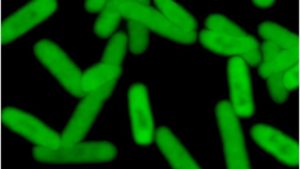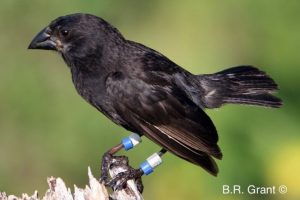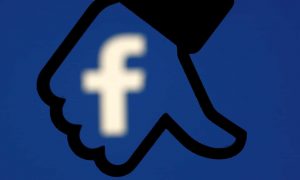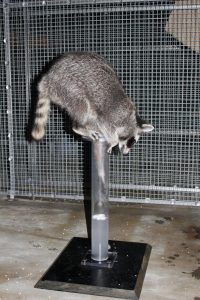Nov
30
2017
 It’s interesting to follow truly cutting edge research that has the potential to significantly change our world. I include in this category research into brain-machine interfaces, regeneration through stem cells, genetic engineering, and fusion energy. I would also add research into creating synthetic life.
It’s interesting to follow truly cutting edge research that has the potential to significantly change our world. I include in this category research into brain-machine interfaces, regeneration through stem cells, genetic engineering, and fusion energy. I would also add research into creating synthetic life.
Synthetic life research views living organisms like a technology. It is, in a way, the original nanotechnology, using complex tiny machines to manufacture chemicals, collect and store energy, degrade toxins, and other functions. Scientists have been very successful in tweaking existing organisms to harness them as tiny factories. Many modern drugs are now made in this way, making drugs like insulin widely available.
Some researchers, however, want to go beyond tweaking existing organisms. What if we could create synthetic organisms, even just single cells, entirely from scratch? That is Craig Venter’s dream – to strip down cells to their bare essentials, and then use that as a template to create a completely artificial minimal generic cell. That basic artificial cell, which we understand well because we built it from the ground up, can then be modified to perform endless functions – designer cells.
There is more to this vision, however. Once we free ourselves from the constraints of existing organisms we can explore novel properties that did not happen to evolve. Evolution is powerful, and it has had several billion years to experiment with life, but evolution is also constrained by its own history. For example, all life on earth uses the same genetic code, based upon two pairs of bases in the DNA – cytosine bonds with guanine and thymine bonds with adenine. This produces a 4-letter alphabet for the genetic code (CTAG), and also gives DNA the double-stranded structure and its ability to make copies of itself. The code consists of 64 3-letter words.
Continue Reading »
Nov
28
2017
 Masaru Emoto thought that emotions can affect inanimate objects. If you are nice to water and then freeze it, it will make pretty happy crystals. If you are mean to water and then freeze it, it will make ugly unhappy crystals. He wrote:
Masaru Emoto thought that emotions can affect inanimate objects. If you are nice to water and then freeze it, it will make pretty happy crystals. If you are mean to water and then freeze it, it will make ugly unhappy crystals. He wrote:
The result was that we always observed beautiful crystals after giving good words, playing good music, and showing, playing, or offering pure prayer to water. On the other hand, we observed disfigured crystals in the opposite situation.
I know – this is ridiculous. Why even bother? Scientific skeptics study pseudoscience for several reasons. What is interesting about Emoto’s research is not the research question he was pursuing (which has close to zero plausibility) but how he had managed to convince himself that his research supported his fantastical notion. Further, he had managed to convince (or at least intrigue) a large segment of the public that he was onto something, and so this presents an opportunity to teach the public about how science works and how we can distinguish it from pseudoscience. Finally, even serious science can fall prey to error and self-deception. Blatant pseudoscience is an excellent opportunity to see pathological science in the extreme, which helps us understand it better phenomenologically, and hopefully then avoid more subtle manifestations elsewhere.
I do want to emphasize that I have no problem with Emoto researching this question (as long as he was not wasting limited public research funds). Exploring seemingly wacky ideas may bear unforeseen fruit. The probability is low, but that is the nature of exploratory research. Fringe research is a good way to keep us on our toes, keep us from getting too complacent or narrow in our view. And very occasionally, we may just get surprised. Even if the hypothesis itself turns out to be hopelessly wrong, we may find something unexpected along the way.
Continue Reading »
Nov
27
2017
 The fight over science in public education continues, and if anything picked up considerably in 2017. Earlier in the year Nature reported on various state laws designed to water down science education or allow for equal time to be given to unscientific views. They report:
The fight over science in public education continues, and if anything picked up considerably in 2017. Earlier in the year Nature reported on various state laws designed to water down science education or allow for equal time to be given to unscientific views. They report:
Florida’s legislature approved a bill on 5 May that would enable residents to challenge what educators teach students. And two other states have already approved non-binding legislation this year urging teachers to embrace ‘academic freedom’ and present the full spectrum of views on evolution and climate change. This would give educators license to treat evolution and intelligent design as equally valid theories, or to present climate change as scientifically contentious.
New Mexico took a more direct approach – simply scrubbing “controversial” ideas from the state’s science standards. The standards no longer mention “evolution”, human contributions to climate change, or even mentioning the age of the Earth. This is not a back door approach – this is straight-up censorship of accepted scientific facts.
A new Florida bill also includes this problematic language:
Controversial theories and concepts must be taught in a factual, objective, and balanced manner.
This is part of the latest strategy. First, don’t mention any one theory (like evolution) by name. That is likely to trigger a constitutional challenge. Second, make the bill sound like it is promoting something positive, like academic freedom, democracy, or just being fair and balanced.
Continue Reading »
Nov
24
2017
 Just two weeks ago I wrote about “Evolution Caught in the Act” – I was writing about fossils that are clearly transitional and occur within a major evolutionary change, like a land animal adapting to aquatic life. Now we have another report that justifies the same title, although this one is in living species.
Just two weeks ago I wrote about “Evolution Caught in the Act” – I was writing about fossils that are clearly transitional and occur within a major evolutionary change, like a land animal adapting to aquatic life. Now we have another report that justifies the same title, although this one is in living species.
For this observation we go back to the beginning, to the Galapagos where Darwin made observations critical to his development of evolutionary theory. The Galapagos are a chain is relatively young volcanic islands, far enough from the mainland to provide relative isolation, but close enough for life to find its way there. Most famously, some ancestral finch species found its way to the island. Their descendants then adapted to a variety of food sources, most obvious in the change in beak size and shape, optimized for its new use.
What Darwin observed is that the Galapagos finches filled many of the same niches as other bird families in other parts of the world. He had to puzzle out why on the Galapagos all those niches were filled by finches. He figured out that they must be descended from an ancestral finch, which also means that they have speciated into a large number of different finch species as they adapted to different islands and different food sources.
Continue Reading »
Nov
21
2017
 Wikipedia is an interesting experiment in amateur crowdsourcing of information. I think it is a massively successful experiment, but it faces specific challenges. This page on Wikipedia discusses their approach to what information they allow to remain in their pages. They have a number of policies and practices that are meant to act as a quality control filter.
Wikipedia is an interesting experiment in amateur crowdsourcing of information. I think it is a massively successful experiment, but it faces specific challenges. This page on Wikipedia discusses their approach to what information they allow to remain in their pages. They have a number of policies and practices that are meant to act as a quality control filter.
In my opinion they have settled upon a reasonable approach that might even be used as a model in other contexts. They begin with a completely open model – anyone can become a contributor and add information to Wikipedia. This is the crowdsourcing angle – many hands make light work. There are currently approximately 5,505,947 articles on the English language version of wikipedia. Wikipedia was founded on January 15, 2001, so that is almost 17 years. It is hard to imaging creating a reference with that much information by any other method in that much time.
So the wiki model is ideal for quantity, but what about quality. From the beginning there were concerns about the quality of the information – if anyone can post information, how can we know how accurate it is? A 2008 study comparing Wikipedia to other references for historical articles found Wikipedia to have an 80% accuracy rating, compared to 95-96% for other references. However, a 2005 Nature study of science entries found that Wikipedia was almost as good as Brittanica online – with no differences in major errors, and with an average of 4 errors total per article for Wikipedia, and 3 per article for Brittanica.
There haven’t been many studies since then, but a 2012 small follow up study found no significant difference between Wikipedia and other sources. Wikipedia has tightened its editorial policies over that time, so the improvement makes sense.
Continue Reading »
Nov
20
2017
 James Randi has often observed that paranormal beliefs are like “unsinkable rubber duckies.” No matter how many times they are knocked down, they just keep popping back up. That’s because they are not based on facts or logic, but motivated reasoning serving some deeper cultural or emotional need. You can counter them with facts, but that is not addressing the real reason for their existence.
James Randi has often observed that paranormal beliefs are like “unsinkable rubber duckies.” No matter how many times they are knocked down, they just keep popping back up. That’s because they are not based on facts or logic, but motivated reasoning serving some deeper cultural or emotional need. You can counter them with facts, but that is not addressing the real reason for their existence.
Conspiracy theories are the same. There is a variety of motivations behind them, having nothing to do with the truth. They result partly from hyperactive pattern recognition and agency detection, serving a need for certainty, feeling special, and defending existing narratives from refutation. A well-tended conspiracy theory is like impenetrable armor that can turn away any fact.
The notion that the US never really went to the moon, and that the entire Apollo program was staged for some reason is one such conspiracy theory. Those who promote the moon landing hoax conspiracy theory depend largely on anomaly hunting – looking for anything that they cannot immediately explain, or that looks odd, and then proclaiming that it is evidence for a hoax. So far every one of their alleged anomalies has been shot down.
They claim, for example, that the lighting in photographs from the moon’s surface is uneven, proving stage lighting. Actually, the opposite is true. The unevenness of the shadows is from the unevenness of the surface of the moon itself. But properly analyzed, the photos show that the lighting is, in fact, parallel. This indicates a distant light source, like the sun. To duplicate this effect on earth, while simultaneously duplicating the lack of diffusion (no atmosphere) would have required many bright white lasers, technology that simply did not exist back then. (Lasers were expensive and only available in red.)
So ironically, what the moon hoax conspiracy theorists end up proving is that the moon landing could not possibly have been faked and was therefore real.
Continue Reading »
Nov
17
2017
 Newsweek, who has been following the story of Italian Neurosurgeon, Sergio Canavero, now reports: “Human Head Transplants Are About to Happen in China: But Where Are the Bodies Coming From?”
Newsweek, who has been following the story of Italian Neurosurgeon, Sergio Canavero, now reports: “Human Head Transplants Are About to Happen in China: But Where Are the Bodies Coming From?”
I have already discussed the scientific aspects of this claim. They are highly implausible and I doubt that such a transplant is about to happen at all. If it does I predict it will be a dismal failure, and ethically dubious. First, I have to reiterate, that it is far more accurate to call such a procedure a body transplant. The head donor will wake up with a new body. The body donor is, I suspect, dead.
There are three basic hurdles that need to be overcome in order to have a successful body transplant – the surgical attachment, suppression of rejection, and regeneration of the attached neurological tissue. Given that Canavero is a surgeon, I suspect he is excited about the first issue. He may think he has made some advances because he improved his technique for making the attachment. This was never, however, the primary hurdle.
We are already making great advances with organ transplantation and controlling rejection. However, this is still a huge issue. Donor and recipient have to be closely matched, and lifelong drugs are required. Still, the amount of tissue being transplanted here will be a challenge. It opens up, for the first time, the possible effects of tissue rejection on an entire brain. While this is a significant hurdle, our current treatments mean it is not necessarily a deal breaker (it might be, but research would be needed to see).
Continue Reading »
Nov
16
2017
 In the season finale of Last Week Tonight, John Oliver reviews Trump’s assault on truth and decency. If you haven’t been watching this show, you should give it a try. Not only is it funny and entertaining, but on each episode Oliver does a deep dive on something in our society that is not right and can be fixed. His researchers generally do a great job, and I also think Oliver does a good job of not being gratuitously partisan.
In the season finale of Last Week Tonight, John Oliver reviews Trump’s assault on truth and decency. If you haven’t been watching this show, you should give it a try. Not only is it funny and entertaining, but on each episode Oliver does a deep dive on something in our society that is not right and can be fixed. His researchers generally do a great job, and I also think Oliver does a good job of not being gratuitously partisan.
His season-long attacks on Trump may not make it seem that way, but I don’t think they are partisan. I also try to keep my personal politics out of my science advocacy, but I think the problems with Trump transcend politics, ideology, and party. In this last episode for the season, Oliver reviews why this is true.
The real problem with Trump is not that he is Republican or conservative – actually you could argue that he is barely either of those things. It’s not even necessarily that he is an anti-establishment populist who wants to shake things up. The real danger of Trump is that he is an anti-intellectual who has been waging war against journalism, expertise, decency, standards, and any notion of objectivity.
For Trump the only thing that appears to matter is the current struggle in which he is engaged – he needs to achieve what he perceives as victory over any adversary, at any cost. Being honest and respecting knowledge and accuracy doesn’t seem to factor in at all.
As a result Trump is willing to sacrifice the basic fabric that is necessary for a functional democracy. He seems to view democratic checks and balances as nothing but an annoyance and obstacle, so eroding that fabric is just another win for him.
Continue Reading »
Nov
14
2017
 Last year Facebook announced that it was partnering with several outside news agencies, the Associated Press, Snopes, ABC News, PolitiFact and FactCheck.org, to fact-check popular news articles and then provide a warning label for those articles on Facebook. How is that effort working out?
Last year Facebook announced that it was partnering with several outside news agencies, the Associated Press, Snopes, ABC News, PolitiFact and FactCheck.org, to fact-check popular news articles and then provide a warning label for those articles on Facebook. How is that effort working out?
According to a recent survey, not so well. Yale researchers Rand and Pennycook found only tiny effects overall, and it’s possible there is a net negative effect from the warning labels. Some people just ignore the labels. Perhaps more significant, however, is the fact that fake news articles that were missed by the fact-checkers were more likely to be believed as real because they lacked the warning label. The fact-checkers could not possibly keep up with all the fake news, so they were overwhelmed and most of the dubious content not only made it through the filters, but benefited from a false implication of legitimacy.
Further, the Guardian reports that this arrangement between Facebook and these news outlets compromise the ability of those news outlets from being a proper watchdog on Facebook itself. If their journalists are being paid by Facebook to fact-check, then they have a conflict of interest when reporting on how Facebook is doing. This conflict is exacerbated by the fact that news organizations are hard-up for income, and could really use the extra income from Facebook.
So it seems that the fact-checking efforts of Facebook were insufficient to have any really benefit, and may have even backfired. Warning labels on dubious news articles may be the wrong approach. It’s simply too easy to foil this protection by overwhelming the system. You could even deliberately flood Facebook with outrageously fake news stories to serve as flack and provide cover for the propaganda you really want to get through. In the end the propaganda will be even more effective.
Continue Reading »
Nov
13
2017
 Animal intelligence is fascinating for a number of reasons, not the least of which is that it forces researchers to think carefully about what intelligence is. The comparison might also provide a window into what constitutes human intelligence in particular.
Animal intelligence is fascinating for a number of reasons, not the least of which is that it forces researchers to think carefully about what intelligence is. The comparison might also provide a window into what constitutes human intelligence in particular.
There is no question that humans have intellectual capabilities that no other species has. However, some animals are smarter in certain ways than you may imagine. Certain birds, like corvids (jays and crows) have demonstrated significant problem-solving capability, for example. Researchers are also finding that raccoons may be even smarter than we suspected.
One paradigm of animal intelligence research is known as the Aesop’s Fable test, based on the the story of the thirsty crow. In this tale a thirsty crow came upon a tall pitcher with water at the bottom, but it could not reach down the long neck to the water. So it dropped stones in the pitcher to raise the water level until it could reach. This behavior demonstrates creative problem-solving and some basic understanding of cause and effect. Corvids have the ability to pass this test – they can figure out how to use objects to raise the water level to gain access to water or food.
A recent study performed the same test on raccoons. They were given access to a long tube with marshmallows floating lower down, too low for them to reach. First they were shown how dropping stones would raise the water level. Two of eight raccoons tests were then able to use this effect to gain access to the marshmallows. Statistically this is not as good a performance as corvids, but at least some raccoons are smart enough to pass the test. Continue Reading »
 It’s interesting to follow truly cutting edge research that has the potential to significantly change our world. I include in this category research into brain-machine interfaces, regeneration through stem cells, genetic engineering, and fusion energy. I would also add research into creating synthetic life.
It’s interesting to follow truly cutting edge research that has the potential to significantly change our world. I include in this category research into brain-machine interfaces, regeneration through stem cells, genetic engineering, and fusion energy. I would also add research into creating synthetic life.
 Masaru Emoto thought that emotions can affect inanimate objects. If you are nice to water and then freeze it, it will make pretty happy crystals. If you are mean to water and then freeze it, it will make ugly unhappy crystals.
Masaru Emoto thought that emotions can affect inanimate objects. If you are nice to water and then freeze it, it will make pretty happy crystals. If you are mean to water and then freeze it, it will make ugly unhappy crystals.  The fight over science in public education continues, and if anything picked up considerably in 2017. Earlier in the year
The fight over science in public education continues, and if anything picked up considerably in 2017. Earlier in the year  Just two weeks ago I wrote about
Just two weeks ago I wrote about  Wikipedia is an interesting experiment in amateur crowdsourcing of information. I think it is a massively successful experiment, but it faces specific challenges.
Wikipedia is an interesting experiment in amateur crowdsourcing of information. I think it is a massively successful experiment, but it faces specific challenges.  James Randi has often observed that paranormal beliefs are like “unsinkable rubber duckies.” No matter how many times they are knocked down, they just keep popping back up. That’s because they are not based on facts or logic, but motivated reasoning serving some deeper cultural or emotional need. You can counter them with facts, but that is not addressing the real reason for their existence.
James Randi has often observed that paranormal beliefs are like “unsinkable rubber duckies.” No matter how many times they are knocked down, they just keep popping back up. That’s because they are not based on facts or logic, but motivated reasoning serving some deeper cultural or emotional need. You can counter them with facts, but that is not addressing the real reason for their existence. Newsweek, who has been following the story of Italian Neurosurgeon, Sergio Canavero, now reports:
Newsweek, who has been following the story of Italian Neurosurgeon, Sergio Canavero, now reports: In the
In the  Last year Facebook announced that it was partnering with several outside news agencies, the Associated Press, Snopes, ABC News, PolitiFact and FactCheck.org, to fact-check popular news articles and then provide a warning label for those articles on Facebook. How is that effort working out?
Last year Facebook announced that it was partnering with several outside news agencies, the Associated Press, Snopes, ABC News, PolitiFact and FactCheck.org, to fact-check popular news articles and then provide a warning label for those articles on Facebook. How is that effort working out? Animal intelligence is fascinating for a number of reasons, not the least of which is that it forces researchers to think carefully about what intelligence is. The comparison might also provide a window into what constitutes human intelligence in particular.
Animal intelligence is fascinating for a number of reasons, not the least of which is that it forces researchers to think carefully about what intelligence is. The comparison might also provide a window into what constitutes human intelligence in particular.




